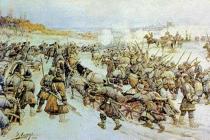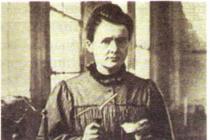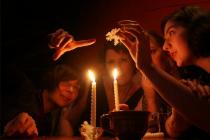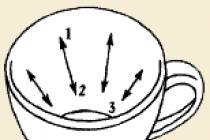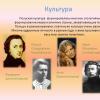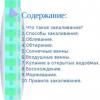Time of Troubles - Chronology of events
The chronology of events helps to better understand how events unfolded during a historical period. The chronology of troubled times presented in the article will help students better write an essay or prepare for a report, and teachers will choose key events that are worth talking about in class.
The Time of Troubles is a designation for the period in Russian history from 1598 to 1613. This period was marked by natural disasters, Polish-Swedish intervention, and a severe political, economic, government and social crisis.
Chronology of events of the Time of Troubles
The threshold of troubled times
1565-1572 - oprichnina of Ivan the Terrible. The beginning of a systemic political and economic crisis in Russia.
1569 - Union of Lublin between the Kingdom of Poland and the Grand Duchy of Lithuania. Formation of the Polish-Lithuanian Commonwealth.
1581 - murder of Ivan Ivanovich's eldest son in a fit of rage by Ivan the Terrible.
1584, March 18 - death of Ivan the Terrible while playing chess, accession to the throne of Fyodor Ivanovich.
1596. October - Schism in the church. The cathedral in Brest, which split into two cathedrals: Uniate and Orthodox. The Kiev Metropolis was divided in two - those faithful to Orthodoxy and the Uniates.
December 15, 1596 - Royal universal to the Orthodox with support for the decisions of the Uniate Council, with a ban on obeying the clergy loyal to Orthodoxy, an order to accept the union (in violation of the law on freedom of religion in Poland). The beginning of open persecution of Orthodoxy in Lithuania and Poland.
The beginning of troubled times
1598 - the death of Fyodor Ivanovich, the end of the Rurik dynasty, the election of boyar Boris Fedorovich Godunov, the brother-in-law of the late tsar, as king at the Zemsky Sobor.
January 01, 1598. Death of Tsar Theodore Ioannovich, end of the Rurik dynasty. The rumor that Tsarevich Dimitri is alive is spreading in Moscow for the first time
February 22, 1598. Boris Godunov’s agreement to accept the royal crown after much persuasion and the threat of Patriarch Job to excommunicate from the Church for disobedience to the decision of the Zemsky Sobor.
1600 Bishop Ignatius the Greek becomes the representative of the Ecumenical Patriarch in Moscow.
1601 Great famine in Rus'.
Two contradictory rumors are spreading: the first is that Tsarevich Dimitri was killed on the orders of Godunov, the second is about his “miraculous salvation.” Both rumors were taken seriously, despite the contradiction, they spread and provided the anti-Godunov forces with support among the “masses.”
Impostor
1602 Escape to Lithuania by Hierodeacon of the Chudov Monastery Grigory Otrepiev. the appearance in Lithuania of the first impostor, posing as the miraculously escaped Tsarevich Dmitry.
1603 - Ignatius the Greek becomes Archbishop of Ryazan.
1604 - False Demetrius I, in a letter to Pope Clement VIII, promises to spread the Catholic faith in Russia.
April 13, 1605 - Death of Tsar Boris Feodorovich Godunov. The oath of Muscovites to Tsarina Maria Grigorievna, Tsar Feodor Borisovich and Princess Ksenia Borisovna.
June 03, 1605 - Public murder on the fiftieth day of the reign of sixteen-year-old Tsar Feodor Borisovich Godunov by princes Vasily Vas. Golitsyn and Vasily Mosalsky, Mikhail Molchanov, Sherefedinov and three archers.
June 20, 1605 - False Dmitry I in Moscow; A few days later he appoints Ignatius the Greek as patriarch.
Tushino camp
May 17, 1606 - Conspiracy led by Prince. Vasily Shuisky, uprising in Moscow against False Dmitry I, deposition and death of False Dmitry I.
1606-1610 - reign of the “boyar tsar” Vasily Ivanovich Shuisky.
June 03, 1606 - Transfer of relics and canonization of St. Righteous Tsarevich Dimitry of Uglich.
1606-1607 - uprising under the leadership of the “voivode of Tsar Dmitry” Ivan Bolotnikov.
February 14, 1607 - Arrival in Moscow by royal command and at the request of Patriarch Hermogenes, the “former” Patriarch Job.
February 16, 1607 - “Letter of Permission” - a conciliar ruling on the innocence of Boris Godunov in the death of Tsarevich Dimitri of Uglich, on the legal rights of the Godunov dynasty and on the guilt of the Moscow people in the murder of Tsar Feodor and Tsarina Maria Godunov.
February 20, 1607 - Reading of the petition of the people and the “letter of permission” in the Assumption Cathedral of the Kremlin in the presence of Sts. Patriarchs Job and Hermogenes.
1608 - False Dmitry II's campaign against Moscow: the impostor besieged the capital for 21 months.
The beginning of the Russian-Polish war, the Seven Boyars
1609 - agreement between Vasily Shuisky and Sweden on military assistance, open intervention of the Polish king Sigismund III in Russian affairs, siege of Smolensk.
1610 - murder of False Dmitry II, mysterious death of the talented commander Mikhail Skopin-Shuisky, defeat by Polish-Lithuanian troops near Klushino, overthrow of Vasily Shuisky from the throne and his tonsure as a monk.
1610, August - the entry of Hetman Zholkiewski's troops into Moscow, the calling of Prince Vladislav to the Russian throne.
Militia
1611 - creation of the First Militia by the Ryazan nobleman Prokopiy Lyapunov, an unsuccessful attempt to liberate Moscow, the capture of Novgorod by the Swedes and Smolensk by the Poles.
1611, autumn - creation of the Second Militia led by Nizhny Novgorod Posad elder Kuzma Minin and Prince Dmitry Pozharsky.
1612, spring - The second militia moved to Yaroslavl, the creation of the “Council of All Land”.
1612, summer - connection of the Second and the remnants of the First militia near Moscow.
1612, August - reflection of Hetman Khodkiewicz’s attempt to break through to the Polish-Lithuanian garrison besieged in the Kremlin.
1612, end of October - liberation of Moscow from the invaders.
Election of the Tsar
1613 – The Zemsky Sobor elects Mikhail Romanov as Tsar (February 21). Mikhail's arrival from Kostroma to Moscow (May 2) and his royal crowning (May 11).
The defeat of Zarutsky and Marina Mnishek near Voronezh.
Lesson type: Seminar in the form of a didactic game.
Lesson form: Meeting of the research departments of the Institute of Russian History.
Lesson Objectives:
- Understand the causes of the Troubles, which was largely a consequence of the oprichnina and the economic and social crisis it caused in the country.
- Realizing that the intervention of Polish and Swedish feudal lords threatened the Russian state with the loss of independence brought the country to the brink of disaster.
- Show the feat of the Russian people (the people's militia of peasants and townspeople), who saved the Fatherland from foreign invaders.
Lesson plan:
- Causes of the Troubles.
- Board of Boris Godunov, Fyodor Godunov. (1598-1605)
- Reign of False Dmitry I (1605-1606)
- The reign of Vasily Shuisky. (1606-1610). False Dmitry II (1607-1610)
- "Seven Boyars" (1610-1613)
- The fight against the Polish-Swedish intervention. Beginning of the Romanov dynasty (February 1613). The end of the Troubles and its results.
Basic Concepts: Troubles, dynastic crisis, interregnum, impostor, seven-boyars, intervention, militia.
Teacher: We will conduct the lesson in the form of a meeting of the research departments of the Institute of Problems of Russian History.
Our institute is represented by five research departments, each of which analyzed the activities of participants in these historical events.
What exactly did your departments do? ( Addresses department heads.)
Department No. 1. We studied and analyzed the activities of Tsar Boris Godunov.
Department No. 2. Analyzed the activities of False Dmitry I
Department No. 3. We studied and analyzed the activities of historical figures: Vasily Shuisky and Ivan Bolotnikov and False Dmitry II
Department No. 4. Analyzed the activities of the “boyar government” - the “Seven Boyars”, and the Polish king Sigismund III
Department No. 5. Studied and analyzed the stages of the National Liberation Struggle against foreign intervention. We analyzed the activities of historical figures: D. Pozharsky, K. Minin, M. Romanov, I. Susanin and others.
Teacher: Class assignment: as the research departments present, fill out the table “Periods of the Time of Troubles”
Teacher: At the end of the 16th century. XVII century The Russian state plunged into long years of hard times and difficult trials.
These events were preceded by:
14 year reign of Fyodor Ivanovich (son of Ivan the Terrible). At least 13 of them were actually ruled by Boris Fedorovich Godunov, whose sister, Irina, the tsar was married to.
Outwardly, the internal situation in the country was calm and stable - the Russian state was gradually recovering from the Livonian War and the oprichnina of Ivan the Terrible. The most notable events of those years were:
The mysterious death of Tsarevich Dmitry 1591 (allegedly beneficial to Boris Godunov).
Election to the kingdom by the Zemsky Sobor in 1598. Boris Godunov because of the death of the childless Fyodor Ivanovich. And three years of the quiet reign of Boris Godunov.
However, this external calm was only apparent. Destructive forces have always lain dormant in the depths of Russian society.
Why, what reasons released these destructive forces into freedom.
Domestic historians name 5 main reasons for the Troubles (Write them in your notebook):
- A sharp deterioration in the situation of peasants due to the abolition of St. George's Day and the introduction of a 5-year search period for fugitives.
- Dynastic crisis - the childless death of Tsar Fyodor Ivanovich. With her, the Rurik dynasty ended.
- The struggle of boyar clans for power. Kindling the fire of civil war.
- Natural disasters - crop failure in 1601, severe famine, epidemics. What was regarded by the people as God's punishment for the atrocities of Boris Godunov (allegedly guilty of the death of Tsarevich Dmitry the Younger son of Ivan IV the Terrible).
- Foreign intervention. Forced intervention of Poles and Swedes in the internal affairs of the Russian state.
THAT. Naming the main causes of the Troubles, historians strongly disagree about how great the significance of each of them was.
The floor is given to the research department that analyzed the activities of participants in historical events under Tsar Boris Godunov.
Research Department No. 1
(student performances)
Teacher: What were the results of this period for the further course of events?
(Students' expected answer: at the beginning of the 17th century, preconditions arose that led to the outbreak of the Time of Troubles (Civil War)).
(Working with a table).
Teacher: Now let’s look at the period of the reign of False Dmitry I. The floor is given to research department No. 2, which analyzed the period of the reign of False Dmitry I.
(student performances)
Main events |
||||
After the death of Tsar Fyodor Ivanovich, the Rurik dynasty came to an end. Election of Boris Godunov to the kingdom by the Zemsky Sobor. 1601-1603 crop failure and famine. 1603 uprising led by Cotton. In 1604, Tsarevich Dmitry, “miraculously saved,” appeared in Poland. The beginning of the impostor's campaign against Moscow. 1605 April sudden death of Boris Godunov. Short reign of Fyodor Godunov (dethroned by the boyars) 1605 April June |
The struggle of the Romanov and Belsky boyars with Godunov for power. The first anti-feudal actions of serfs and serfs. The beginning of hidden intervention on the part of the Polish-Lithuanian Commonwealth. |
B. Godunov, F. Romanov (Filaret), Patriarch Job, Cotton Kosolap, Grigory Otrepiev (False Dmitry), Sigismund III. |
Preconditions arose that led to the beginning of the Troubles (Civil War). Boyar period of Time of Troubles. The main instruments of politics are rumors and denunciations. |
Research Department No. 2
(student performances)
Table “Periods of the Time of Troubles”
Chronological framework of the period |
Main events |
Characteristics of opposing forces |
Names of the most significant participants |
Results of the period, its significance for the further course of events |
11-month reign of False Dmitry I. Filaret (F. Romanov) was appointed Metropolitan of Rostov. The impostor took the title of emperor. Attempts to ensure the interests of all social strata of Russia. Wedding of False Dmitry with Catholic Marina Mnishek. The atrocities of the Poles in Moscow. A conspiracy of the boyars led by Vasily Shuisky against the impostor. Murder of False Dmitry. |
The beginning of open intervention on the part of Poland. Conspiracy of the boyars led by V. Shuisky against False Dmitry I. |
False Dmitry I (Grigory Otrepyev), Marina Mnishek, Vasily Shuisky. |
Russia is faced with imposture for the first time. Internal contradictions in the country are intensifying. |
Research Department No. 3
Teacher: The floor is given to the research department that analyzed the period of Vasily Shuisky’s reign.
Historical meaning. The uprising under the leadership of I.I. Bolotnikov was caused by the increased exploitation of peasants, the consequences of lean years, famine and the general weakening of the central government. This was the first major peasant uprising, civil war, anti-feudal movement.
Teacher: What were the results of this period for the further course of events?
(Students' answers)
(Working with a table)
Teacher: The floor is given to research department No. 4, which analyzed the period of rule of the “Seven Boyars”
Table “Periods of the Time of Troubles”
Chronological framework of the period |
Main events |
Characteristics of opposing forces |
Names of the most significant participants |
Results of the period, its significance for the further course of events |
Election of the “boyar” Tsar Vasily Shuisky by the Zemsky Sobor. Hermogenes becomes patriarch. Tsarevich Dmitry was reburied in Moscow and canonized. "Kissing Record". 1606-1607 Uprising led by Ivan Bolotnikov. 1607 - decree on a 15-year search for runaway peasants. 1607-1610 - attempt of False Dmitry II to seize power in Russia. Polish-Swedish intervention in Russia. Removal of V. Shuisky from power by the boyars. |
The lower and middle strata of society (posad people and the nobility) oppose the upper classes. |
Vasily Shuisky, M. Molchanov, Ivan Bolotnikov, False Dmitry II, Marina Mnishek. |
The beginning of a full-scale Peasant (Civil War). Intensification of the class struggle. |
Teacher: The floor is given to research department No. 4, which analyzed the period of the Russian people’s struggle against intervention.
Research Department No. 5
Teacher: The floor is given to research department No. 5, which analyzed the decision of the Zemsky Sobor - the election of Mikhail Romanov to the kingdom.
(student performance)
Teacher: To end the Time of Troubles as quickly as possible, the country needed a legitimate monarch recognized by all layers of society. To this end, the leaders of the Second Militia already at the end of 1612 sent letters to the cities demanding that representatives of the estates be sent to the Zemsky Sobor.
In January 1612, elected representatives of all classes of Russia came to the Zemsky Sobor in Moscow - boyars, nobles, church leaders, townspeople, Cossacks, black-sown and palace peasants. The interests of serfs and serfs were represented at the Council by land owners. Never before has there been a representative body of such a wide composition in the country.
The Council had one task - the election of a monarch.
There were several candidates for the throne, ranging from foreigners (Swedish and Polish princes), the son of Marina Mnishek and False Dmitry II, and ending with Russian contenders: F.I. Mstislavsky, V.V. Golitsyn, D.M. Trubetskoy, D. Pozharsky, M. Romanov, D.M. Cherkassky, P.N. Pronsky et al.
Initially, the members of the Council decided not to elect a foreign representative to the Russian throne and rejected the candidacy of the son of Marina Mnishek and False Dmitry II, Ivan.
As a result of heated debates, the candidacy of 16-year-old Mikhail Fedorovich Romanov turned out to be the most acceptable. Why did the choice fall on a young man who had no life experience? Moreover, at the time of his election he was not even in Moscow. (He stayed on his estate in Kostroma district). He became a real contender not because he was better, but because, ultimately, he satisfied everyone.
The son of the Tushino Patriarch Filaret, behind him stood the halo of his father - a martyr who was in Polish captivity. Perhaps Mikhail Romanov’s proximity to the Rurik dynasty also played a role, since he was the grandson of Ivan the Terrible’s first wife Anastasia Romanova (Geneological tree of M. Romanov).
One of the influential boyar electors expressed their opinion this way: Misha Romanov is young, his mind has not yet reached him, and he will be familiar to us.
Thus, the election of the Romanovs to the kingdom promised universal consent and peace; this happened on February 21, 1613.
The Zemsky Assembly sent ambassadors to the Ipatiev Monastery (near Kostroma), where Mikhail Romanov and his mother were. The nun Martha, who feared for the fate of her son, agreed to his accession only after much persuasion. Russia has gained a legally elected monarch.
The Polish detachments remaining on Russian soil, having learned about the election of Mikhail Romanov to the kingdom, tried to seize him in his ancestral Kostroma possessions in order to free up the Russian throne for their king. Making their way to Kostroma, the Poles asked the peasant of the village of Domnino, Ivan Susanin, to show the way. According to the official version, he refused and was tortured by them, and according to popular legend, Susanin agreed, but sent a warning to the king about the impending danger. And he himself led the Poles into a swamp, from which they were unable to get out. Realizing the deception, they killed Susanin, but they themselves died in the thicket from hunger and cold. The legend of Susanin’s feat served as the plot for M. Glinka’s opera “A Life for the Tsar.”
Susanin's feat seemed to crown the general patriotic impulse of the people. The act of electing a tsar and then crowning him king, first in Kostroma and then in the Assumption Cathedral of the Moscow Kremlin, meant the end of the Time of Troubles.
Teacher: What were the results of this period for the further course of events? (filling out the table).
Results of the Troubles:
- Destruction of productive forces (recovered only after 50 years).
- Loss of territories (the coast of the Gulf of Finland, the Karelia region and access to the Baltic, loss of Smolensk, Chernigov).
- Weakening of all government structures.
- The nature of royal power has changed (the king was elected).
- The status of the church has increased.
Thus ended the Time of Troubles - a severe shock at the beginning of the 17th century, which, in its nature, the severity of socio-political confrontation and the methods of resolving contradictions, many researchers equate to a civil war.
Thus, basically the territorial unity of Russia was restored, although part of the Russian lands remained with the Polish-Lithuanian Commonwealth and Sweden.
After the Time of Troubles, a choice was made in favor of preserving the largest power in eastern Europe.
Table “Periods of the Time of Troubles”
| Chronological framework of the period | Main events |
Characteristics of opposing forces |
Names of the most significant participants |
Results of the period, its significance for the further course of events |
The establishment of the “boyar government” in Russia – “Seven Boyars”. Invitation to the Russian throne of Vladislav, the son of the Polish king. Death of False Dmitry II. Occupation of Moscow by the Poles. The call of Patriarch Hermogenes to the Russian people to rise up in the liberation struggle against foreign invaders. 1611, January - June - activities of the First (Ryazan) militia. 1611, September - October - formation of the Second Militia in Nizhny Novgorod under the leadership of K. Minin and D. Pozharsky. |
Full-scale intervention of the Poles and Swedes. The rise of the people to fight against foreigners. |
Members of the "Seven Boyars": F. Mstislavsky, I. Vorotynsky, A. Trubetskoy, A. Golitsyn, B. Lykov, I. Romanov, F. Sheremetev. Vladislav Sigismundovich Vasa, Sigismund III, Patriarch Hermogenes, P. Lyapunov, I. Zarutsky, D. Trubetskoy, K. Minin, D. Pozharsky, Mikhail Romanov, Ivan Susanin. |
National upsurge in Russia. The civil war develops into a national liberation war. Liberation of Moscow from Polish invaders. Restoring the country's independence. Zemsky Sobor of 1613 and the restoration of autocracy. The first Romanovs. The end of the Troubles. |
Teacher(consolidation of the material covered): I want to end the lesson with the words of the ancient Greek philosopher Aristotle: “If we know the reasons leading to the death of state structures, then we thereby know the reasons that determine their preservation.”
The Time of Troubles is a civil war in Russia, complicated by the struggle with the Polish-Lithuanian Commonwealth and Sweden.
The reign of Fyodor Ivanovich (1583 - 1598).
After the death of Ivan the Terrible, power passed to his 27-year-old son Fedor. The second Russian Tsar was not very inclined to rule, and entrusted the leadership of the country to his associates, first of all, to Boris Godunov. He was the brother of the Tsar's wife Irina.
1589 g. - Metropolitan Job (Godunov’s protege) became patriarch, which increased the prestige of the church.
1591 g. - The Tsar’s younger brother, Tsarevich Dmitry, dies in Uglich. A commission headed by Vasily Shuisky ruled that it was an accident, but the people thought of Godunov. The commission included boyars with very different political views; Vasily Shuisky, who had recently returned from exile, was perhaps Godunov’s main opponent. This, as well as the fact that many of the witness statements that have reached ours are signed and there is no doubt about their authenticity, we can with a high degree of probability talk about an accident.
This is interesting. The last son of Tsar Ivan was named after the first - who died in an accident without living even a year.
1597 - the code on slaves, according to which voluntary slaves who served for more than six months remained slaves for life.
Boris Godunov (1598 – 1605).
After the death of Fyodor Ivanovich, the Zemsky Sobor chose Boris Godunov as tsar. Feeling the fragility of his position, Boris Godunov made a mistake - he decided to rely on the people: tax arrears were removed, direct taxes were replaced with indirect ones, and the peasants’ right to march on St. George’s Day (1601) was partially restored. To support the urban poor, he started global construction projects. The situation in the country was returning to normal, but this did not bring the sovereign support from the people.
Boris Godunov also established relations with European countries, tried to invite foreign specialists to Russia - which, however, was hindered by border countries (primarily the Polish-Lithuanian Commonwealth) and even doctors had to make their way to Moscow under the guise of merchants. He also gave benefits to English and Dutch merchants, hoping to revive international trade. In 1600, the first Russian students, who came from clerk families, went to England. Thanks to the tsar’s patronage, Russian students had the opportunity to study at Oxford and Cambridge. In 1603, the king paid for the education of five young people in Lübeck (Germany).
Under the influence of foreigners, Russians begin to shave their beards.
1600- The king became seriously ill. The Romanov boyars gathered a large detachment at their Moscow courtyard, hoping to seize power after the death of Boris Godunov. The sick ruler sent several hundred archers after them; the Romanovs put up fierce resistance, but were arrested. The closest servants of the Romanovs were executed - one of these servants was supposed to be Grigory Otrepiev, but he managed to become a monk, which saved him from the gallows.
The Polish-Lithuanian Commonwealth and Russia in 1600 concluded a 20-year peace, beneficial to both parties.
1601-1603– due to climate deterioration (the most severe cooling in Europe over the last thousand years), the country experienced crop failure for three years in a row. A severe famine broke out (sources contain information about 120 thousand deaths in Moscow alone), as a result of which a large number of fugitives appeared, who in turn formed into bands of robbers. In 1603 it began Cotton's rebellion. After several battles, the rebels were defeated, Cotton himself was executed, but most of his army fled and hid.
They committed robbery not only on the roads, but also in the cities. Boris Godunov is forced to take special measures to restore order in the capital.
Cossacks. At this time, the Cossacks, mostly runaway peasants, became an influential force. In the Polish-Lithuanian Commonwealth, the Cossacks were concentrated in Zaporozhye, in Russia on the Don (also on the Volga and Yaik). Both of them aroused dissatisfaction and fears of the authorities, who, however, could not do anything about them.
Foreign policy of Fyodor Ivanovich and Boris Godunov.
The defeat in the Livonian War permanently undermined Russia's position in the international arena. Truces did not guarantee security. In 1591, the Crimeans carried out a devastating raid, but because... The Crimean Khanate was supposed to support Turkey in the war with Hungary; they often could not carry out raids, and moreover, they themselves suffered from the raids of the Don Cossacks.
Attempts were made to return to the Baltic. The confrontation with Sweden has escalated. As a result of the campaign of 1590, the cities of Yam, Koporye and Ivangorod were taken. In 1592, an unsuccessful campaign against Vyborg. In the same year, peace was concluded with Poland for 12 years. 1595 - peace with Sweden, according to which the cities occupied by Sweden in 1580 went to Moscow. In fact, at this time in the Baltic, three states compete for the Livonian cities - the Polish-Lithuanian Commonwealth, Sweden and Russia. Blocks were possible between them from time to time, but they were short-lived.
False DmitryI.
1603- an impostor appears within the Polish-Lithuanian Commonwealth, in whom the Ambassadorial Prikaz immediately became interested. Russia officially demanded that he be extradited, but the wealthy tycoon Adam Vishnevetsky, who patronized False Dmitry, refused. At this time, on behalf of the tsar, an investigation was underway into the identity of the impostor, and at the end of the year it was announced in Moscow that it was a runaway monk of the Kremlin Chudov Monastery, Grigory Otrepiev.
Magnates - large feudal lords in the Polish-Lithuanian Commonwealth; gentry - nobility in the same place.
Initially, Otrepiev enjoyed the support of the influential Orthodox tycoon Vishnevetsky, but later defected to the influential Catholic Yuri Mnishek. He introduced him to the king, and even married him to his daughter Marina. At the same time, False Dmitry converted to Catholicism, which won over the papal representative to his side.
Under the patronage of Mnishek, Otrepiev received support from King Sigismund III. In exchange for this, he promised to give up part of the Russian territories (Chernigov-Seversk land and Smolensk land) and help the king in taking over the Swedish crown. Marine Mniszech, as the future queen, Pskov and Novgorod were promised to govern her, and her father was promised a million Polish zlotys. He also pledged to bring all of Russia to Catholicism within a year.
1604– False Dmitry with a small detachment invades Rus', where he is greeted with delight by representatives of almost all classes: nobles, peasants, serfs, Cossacks.
This is interesting. In 1604 Boris Godunov and False DmitryIcorrespond with Patriarch Sophronius of Jerusalem. In his letters, the Patriarch of Jerusalem wishes victory over the enemies to each of his correspondents, and also asks them to help him financially - in paying off debts to the Arabs. He also asked the impostor to help return two Arabian horses captured by Adam Vishnevetsky, Otrepyev’s first patron.
1605- government troops crush the rebels, False Dmitry wants to flee to Poland, but his associates stop him and he continues military operations.
May 1605- news comes of the death of Tsar Boris, and state troops go over to the side of the impostor. At the beginning of June, an uprising breaks out in Moscow in which the young Tsar is killed - Fyodor Borisovich Godunov. Soon False Dmitry enters Moscow and is crowned king.
17 May 1606 An uprising breaks out in Moscow as a result of which False Dmitry dies. The cause of the uprising was the ill-considered actions of the impostor:
1). He gradually lost the support of Poland and the Catholic Church, delaying the fulfillment of the promises he made before the campaign against Rus'.
This was aggravated by the fact that the boyar circles (Shuisky and Golitsyn) of Moscow at that time were oriented towards Poland, and at the end of 1605 they sent an embassy to Poland, where they reproached King Sigismund for helping the impostor and hinted at the possibility of giving the throne to his son Vladislav.
2). Marriage in early May 1606 to Marine Yurievna Mnishek. Marriage to a Catholic woman was extremely disappointing to both the people and the boyars.
3). Peasants and Cossacks also gradually became disillusioned with the new tsar. So under him, the period of “lesson years” was increased from 5 to 6 years. The Cossack army was disbanded.
4). The Poles, with the connivance of False Dmitry, committed outrages in Moscow, which they perceived as conquered territory.
5). Rumors began to appear about the king's conversion to Catholicism. This, coupled with his foreign manners - he surrounded himself with Poles, did not wear a beard - alienated people from him.
After the overthrow of False Dmitry, the kings shouted Vasily Shuisky (1606 – 1610). However, almost immediately after the appearance of the new ruler, rumors began to spread that False Dmitry miraculously escaped and fled to the Polish-Lithuanian Commonwealth. Shuisky’s opponents immediately appeared, led by Ivan Isaevich Bolotnikov. He led an army in which all classes of Rus' were represented and headed towards Moscow, regularly winning victories over government troops. From October to December 1606, Bolotnikov’s troops besieged Moscow, but at that time disagreements began among the rebels and many went over to Shuisky’s side. Gradually, the advantage passed to supporters of the legitimate government, Bolotnikov’s troops were defeated, and his troops fled to Kaluga and Tula, where for a long time they successfully defeated the troops sent after them. However, luck gradually turned away from them and in October 1607, Bolotnikov and other leaders of the uprising agreed to surrender, subject to the protection of their lives. Shuisky agreed, but subsequently executed everyone.
Summer of 1607 a new impostor has appeared - False DmitryII. After the defeat of Bolotnikov’s troops, many survivors joined the new contender for the throne. He was also “recognized” by the wife of False Dmitry I, Marina Mnishek. The impostor organized his capital in Tushino (Moscow remained with Shuisky), from the location of his headquarters he received his nickname - the Tushino thief.
The war between Shuisky and False Dmitry II proceeded with varying degrees of success, although the position of the impostor looked more confident. In 1609, Tsar Vasily took a desperate step - he asked for help from the Swedes, in exchange for renouncing claims to the Livonian lands and the city of Korela with the district. The united Russian-Swedish troops were led by one of the best military leaders of this time, the Tsar’s nephew - Mikhail Skopin-Shuisky. In a short time, he defeated the main troops of the Tushino thief, and liberated Tushino, thereby unblocking Moscow. In March 1610, Skopin-Shuisky, at the head of his troops, solemnly entered Moscow, where he was poisoned at a feast at Prince Vorotynsky. Contemporaries blamed the tsar and his brother Dmitry Shuisky for this crime.
Fighting external threats.
In the autumn of 1609- the army of the Polish king Sigismund III begins the siege of Smolensk. This city resisted for 20 months and fell only on June 3 1611 g.
In the summer of 1610, False Dmitry II again approached Moscow (soon, however, his troops were again defeated, and he himself was killed). In these circumstances, the Moscow boyars overthrow Tsar Vasily and forcibly tonsure him into a monk. Power passes to a temporary oligarchic body - the “Seven Boyars”. In turn, the Seven Boyars decide to invite the Lithuanian-Polish prince Vladislav to the throne (preliminary negotiations about this were conducted back in 1605).
The decision to call the Polish heir to the Russian throne was not popular among the people. And in the spring of 1611, an uprising against the Poles broke out in Moscow. It was quickly suppressed; one of the leaders of the uprising, Prince D.M. Pozharsky, wounded, is forced to flee the capital.
In the summer of 1611, troops of the first militia arrived under the walls of Moscow. Unlike Moscow, most Russian cities did not want to swear allegiance to Vladislav, and to fight the Polish threat, a militia was assembled in Ryazan, headed by P. Lyapunov. The main driving forces of the militia were the Cossacks and nobles. At first, things developed well for the militia; the Poles were locked in Moscow and did not pose a threat. However, a conflict broke out between the Cossacks and the nobles, as a result of which Lyapunov was killed, after which the nobles left near Moscow.
1610-1611. - embassy of Moscow boyars, in which Filaret (Romanov) participates, to Poland. The purpose of the trip was to defend the preliminary agreement on the conscription of Tsarevich Vladislav to the throne, subject to his conversion to Orthodoxy.
Summer 1611. was marked by two defeats of the Russian people - fell Smolensk, Sigismund III proclaimed that he himself would rule in Moscow, and the Swedes captured Novgorod.
Against this background, a new militia begins to gather in Nizhny Novgorod, led by the “posad elder” Kuzma Minin and Prince Dmitry Pozharsky. Soon, detachments from other cities began to join the militia. The army of Minin and Pozharsky went to Moscow and besieged it. IN October ( according to the new style November 4) 1612. The Poles, unable to withstand hunger, capitulated.
1 The main campaigns of Crimeans: 1552- an attempt to take advantage of the Russian campaign against Kazan. A complete failure, Devlet-Girey, afraid to engage in battle with the main Russian army under the command of Ivan the Terrible, unsuccessfully tried to capture Tula and was forced to flee when Russian reinforcements approached. 1555– a new Tatar raid began with an incident. According to their custom, the Crimeans, leaving a convoy and spare horses in front of the border, set off for Rus'. They did not know that they were bypassed with the army of the governor Sheremetyev, who without any problems captured this convoy and horses (60K) and sent them to Rus', accompanied by about half of the army. It let him down. Devlet-Girey, having learned that Ivan the Terrible was coming at him, turned around and began to retreat, where he came across Sheremetyev’s detachment, which was inferior in number (5-8 times), which he defeated with great difficulty. 1562- the Tatars plundered the settlements of Mtsensk, did not take the city and hastily retreated. 1564 g. - peace negotiations were conducted, but Divlet-Girey unexpectedly and very successfully went to Rus'. He besieged the weakly fortified Ryazan, was unable to take it and was forced to retreat without waiting for all the detachments “disbanded for war” and many of which were defeated by the Russians. 1565 g. – one day hike. Russian troops were waiting for the steppe inhabitants, and the Crimeans hastily released, abandoning their foragers. For the first time they took part in the campaign against the Tatars guardsmen. 1571- the most successful campaign of the Crimeans, as a result of which Moscow was burned . 1572- the defeat of the Tatars in the Battle of Molodi from which they could not recover for a long time.
Letter of the Russian government to the French king (excerpts): "...In the past, in 109 (1601), Zhigimont, the king of Poland and the Grand Duke of Lithuania, sent his ambassadors, the chancellor of the Grand Duchy of Lithuania Lev Sopega with his comrades, and those ambassadors and our boyars sentenced a truce between the Tsar and V.K. Boris Fedorovich of all Russia and between Zhigimont the King of Poland and between their great states for twenty two years, from the summer of 7109 to the summer of 7131, and that truce was Tsar Boris and Zhigimont the King godfather with a kiss with their souls they sealed what was in those years of peace for them, the sovereign and the state with the state to be in peace and in friendship and in love, and not to start wars or any unfriendliness, and not to send people to the land of the Moscow state, and through their land no do not allow people to pass through the military, and do not help the enemy with any people or treasury. And after that fortification, soon, a certain thief, a black heretic named Grishka Bogdanov, the son of Otrepiev from the Moscow state, for some of his evil godly deeds, fled to Lithuania, and threw off his black dress and he gave the handwriting to himself as an enemy, if he accepted the royal throne, he would be excommunicated from God, and called himself Tsarevich Demetrius of Uglitsky, the grandfather of our great sovereign, the Tsar, and V. K. Ivan Vasilyevich of All Russia, son; and Tsarevich Dmitry Ugletsky had died thirteen years before that time; and in Poland, on the advice and intention of Radny Pan, the governor of Sendomirsky Yury Mnishka, Prince Adam and Prince Kostyantin Vishnevetsky, and Ostryanskaya headman Mikhailo Ratomsky and many other Polish and Lithuanian people accosted that thief, and brought that thief Grishka Rostriga to King Zhigimont, namenuich he is the royal son, as if they truly know about him, that he is the son of our grandfather... Tsarevich Dmitry Ugletskaya. And that thief beat his forehead to the king for help, so that he could be sovereign in the Moscow state; and for that, he himself will be committed to the king and with our great Russian state in citizenship, and King Zhigimont, violating the peace decree and violated his kiss of the cross, which was approved with Tsar Boris... he gave that thief a lot of his treasury for help, and people against Tsar Boris and the Moscow State, and the Radnaya Koruna Polish governor of Sendomierz Yuri Mnishek, by royal command, spoke his daughter Marina for that thief, and gave him a lot of treasury to help him, and he himself went with him to the Ukraine of the Moscow State with military men; and that thief Grishka Otrepiev and the governor of Sendomirskaya with many Polish and Lithuanian people came to the Ukraine of the Moscow state in the Seversky cities unknown; and Tsar Boris, knowing the peace decree and between himself and King Zhigimont about that fortification, in the Seversky cities from the Lithuanian Ukrainians did not keep profitable military men, and that thief took some Sversky cities by mistake, and taught other cities of the Moscow state to gain access, and the king’s letters I taught on my own behalf to write about the troubles in all the cities of the Moscow state to all sorts of people, the name of that thief, the grandfather of our great sovereign. .. Ivan Vasilyevich of All Russia by his son Tsarevich Dimitri Ugletsky, so that they would stand against him, but he wants to help everyone in the Moscow state with people and treasury; and how it was known to Tsar Boris and our Moscow state boyars that such an evil deed began from King Zhigimont and from Koruna The Polish in the years of truce |... sent to Poland and Lithuania to the lords of the Rada as messengers Smirnov Otrepiev, and he Smirnoy that thief is his own uncle, and they ordered him to speak to Mr. Rada, so that Mr. Rada and his nephew and the thief, who is called Tsarevich Dmitry, would decide face to face, and he would expose his theft, and His Holiness Iev the Patriarch of Moscow and All Russia, and metropolitans, and archbishops, and bishops, and the entire Consecrated Cathedral deliberately sent with their letters to the Radny masters in Kiev, to Prince Vasily Ostrozhsky, a messenger Afonasy Palchikov, and wrote about that thief, about Grishka Otrepiev with testimony about how he was in Moscow state as a deacon, and for what evil thieves of his he ran from the Moscow state to Lithuania, and they believed everything that was written in the letter, but they didn’t believe in that thief and his enemy’s charms in anything, and they ordered him to be caught and they would send him to the Moscow state, and over him, as an enemy in the rule of the saints, the father and according to the Council Code, punishment would be inflicted for his villainous deeds, so that for that peaceful resolution would not be violated, and among the great sovereigns I was most unloved and between states from such is the thief, from his demonic charms, confusion and bloodshed did not arise; and King Zhigimont and the Lords of the Rada did not believe it all, Smirnova Otrepiev with that thief with his nephew Evo with Rostrig, they did not put him in plain sight, and the Rada Lords Prince Vasily of Ostrozhskaya put the Patriarchal Prince Afonasy Palchikov in their fortress and did not let him go back. And how the governor of Sendomir Yuri Mnishek and his son, and Ostryansk elder Mikhail Ratomskaya and other lords came with that thief and many Polish and Lithuanian people to the Russian state in the North and taught to seduce and intimidate the local Sevryuks with the royal name, as if Zhigimont was king and The lords of the Rada truly found out about him that he is a direct prince, and they want to stand for him with all of Poland and Lithuania, and they are going with them to the Moscow state by royal command and the Panov Rada. And Tsar Boris, seeing Zhigimont’s queen lie through the kiss of the cross, sent that thief to denounce his envoy Posnik Ogarev on purpose to Zhigimont, the King of Poland and the Grand Duke of Lithuania. And about this, Tsar Boris ordered the king with his envoy to Zhigimont whether he should continue to maintain the truce that the ambassadors of his great chancellor had made... Lev Sopega with his comrades, and archbishops and bishops at the same time again sent Polish korunas to the Rada and the Grand Duchy of Lithuania to the arcibiskup and biscop and to the entire clergy with letters... their envoy Andrei Bunakov about the same thief, and wrote about him authentically with a certificate, so that the lords of the Rada would not believe that thief and the peasants would not shed blood through the kiss of the cross , and did not violate the peace decree. And King Zhigimont and the lords of the Rada in front of Tsar Boris’s envoy denied everything, but said that they were not helping that thief in anything and were not violating the peace regulations and wanted to keep it going forward. And having sent away his envoy to Tsar Boris, the former king and lords of Zhigimont taught that he was glad to help that thief in every possible way, and from the Polish and Lithuanian cities and from all the border places to the Moscow state, the elders and sovereigns constantly sent sheets, calling that thief direct Tsarevich Dmitry Ivanovich, so that they do not stand against that thief and succumb to him, and for the net stands their Polish sovereign, King Zhigimont, and the Radnye gentlemen with all the Polish and Lithuanian lands go with that thief to the Moscow state in war...; and at the same time, by God's righteous judgment of the Tsar and Grand Duke Boris Fedorovich, all Russia was no longer in the stomach, and in the kingdom of Moscow there began to be discord and civil strife and bloodshed, which, believing such turmoil and fearing war and ruin from the Polish and Lithuanian people they accosted the thief, and our boyars and the governor, who were in the regiment, stood against that thief... having tied him up, they brought him to that thief. And through the enemy’s action, and through the intention and assistance of King Zhigimont... that thief reached the reigning city of Moscow... and reached the royal throne, and was named the sovereign of Moscow. And with him came to the reigning city of Moscow many Polish and Lithuanian people, and Don and Volsky atamans and Cossacks, who fled from our Moscow state for their guilt from the death penalty. And having become the sovereign of the Moscow state, that thief sent many boyars and governors and all sorts of people into captivity throughout the cities, and executed others with capital punishment. And then the governor of Sendomirsky Yurya Mnishek came from Lithuania to that thief with many Polish and Lithuanian people, and brought with him... according to an agreement with that thief, his daughter Marina and gave him as a wife, and together with the governor of Sendomirsky they came from the king to To the same thief, ambassadors Mikalay Aletnitskaya, the castellan of Mologovskaya, and Alexander Ga(n)sevsky, a royal nobleman, with many people, organizing regiments and companies, as if in military affairs, and not like before, ambassadors and envoys from Poland and Lithuania walked around, congratulating that thief in the state and the king declaring his friendship to him, that he had committed himself against the Moscow state and was himself with our entire Moscow state under his citizenship, on which there was an agreement with him. And being in Moscow, those Polish and Lithuanian people... began to do a lot of desecration to our peasant faith, and... to do a lot of violence to people, and that thief Grishka planned with the Poles the Patriarch of Moscow and the metropolitans and archbishops and bishops and boyars and governors and beat all kinds of people of the best ranks, and bring the Moscow state under the Polish crown, and corrupt our Orthodox Christian true faith of the Greek law. And our Moscow state boyars and governors and all sorts of people, seeing such evil from that thief Rostrig and from the Polish and Lithuanian people, could not tolerate such evil, they all united with one mind and put that evil thief to death. And those Polish and Lithuanian people stood up for him and taught him to beat Russian people, and those few zemstvo black people beat for their rudeness; and our boyars saved the governor of Sendomirsky with his daughter and his friends Vishnevetsky and other Polish and Lithuanian people from death.... And the king Zhigimont himself and the Lords of the Rada, intending to ruin the Moscow state more than the previous one, rushed to create unrest in the Moscow state and shed peasant blood in vain, they ordered let glory spread to all the border places of the Moscow state and to the Don to the Cossacks, as if the thief who was the sovereign in Moscow left Moscow and is alive among them in Poland, and in his place some Litvin was killed. Yes, they deliberately sent another thief of Jewish origin to the Ukraine of the Moscow state in the Seversk land, calling him Tsar Dmitry by the same name by which the former thief Rostrig was called, as if that thief had escaped from murder from Moscow. And with that other thief came, at the royal command, many Polish and Lithuanian people, Prince Romon Ruzhensky, and Alexander Samoilov, son of Zbarovskaya, and Prince Adam Vishnevetsky, and Jan Peter Sapieha, and Samoilo and Jan Tyszkievich, famous hetmans and colonels, and other colonels and captains with many Polish and Lithuanian people, and began to send out vague letters throughout Severskaya and in cities and places, naming that thief as the former thief Dmitry. And the people of the Moscow states of the Ukrainian Seversky cities, seeing ruin and war from the Polish and Lithuanian people, could not stand against them, they pestered that thief, and there began to be discord among the people and bloodshed greater than before. And that other thief came with the Polish and Lithuanian with many people and from the Cossacks and from Cherkasy to the reigning city of Moscow, and when he came close to Moscow they began a tabar, and in the cities... they dissolved the war in the districts, and began... to ruin the villages and villages burn, and kill people, and beat and rob others and shed blood in vain without mercy, and approach the reigning city of Moscow. .. And by the grace of God, that thief did not get his desire from Moscow, many of his Polish and Lithuanian people were beaten from Moscow and kicked out of the camp. And that thief with the Polish and Lithuanian people, running out of the camp from near Moscow, taught them to stand in the city of Kaluga... and taught the exile with the Polish king Zhigimont. And the Polish king Zhigimont... himself came with an army and with an outfit... to the city of Smolensk with many Polish and Lithuanian and other lands with hired people. And having besieged the city of Smolensk, he ordered the city to be hit with shells and attacks and undermining the city of Smolensk with roses... And Tsar Vasily, seeing the Polish king Zhigimont committing the crime of the cross, and from him and from the thief there was trouble, the ambassador to Veliky Novgorod of his boyar Prince Mikhail Vasilyevich Shuisky, and ordered him from the New Town with the former King Carlus of Sveisky, the current Adolf King of Sveisky’s father, to refer to hired people…. of the former Sveyskaya, King Karlus, through exile with the boyar with Prince Mikhail Vasilyevich Shuisky, sent military people of your state of French and Sveyan and other lands with his governor with Yakov Puntosov to Veliky Novgorod... and with a kiss of the cross and letters with Yakov Puntosov they strengthened on what it was for Yakov Puntosov, with all his military men who came with him, to stand against the Polish and Lithuanian people and fight with them... for the entire Moscow state, strong to death, and not to commit any treason against the Polish people drive away... the Sveisky King Karlus, the governor Yakov Puntosov, and Ivern Gorn, having forgotten their oath... with and seven of their people... betrayed, drove off to the Polish hetman to Stanislav Zhelkovsky, and stood with him against the boyar Prince Dmitry Ivanovich Shuisky, and the Russian people and which was sent to the treasury for the German people with the boyar with Prince Dmitry Ivanovich Shuisky, and after him money and gold, and sables, and all kinds of expensive ornaments of the royal treasury were sent to him, then Yakov Puntus and his people plundered everything and divided it among himself ... (and) went to the Great New City, burning and fighting and full of people. And other German military men, having come by deceit to the Nougrodtsky suburb of Ladoga, took it and shed a lot of blood. And with the Polish hetman Stanislav Zhelkovsky, Yakov and Ivern Gorn left many of their military men... And with the intention of the Polish Zhigimont, the king of Moscow to bring the people of Moscow into turmoil, he wrote and ordered with hetman Stanislav Zhelkovsky to Moscow to the boyars and governors and all ranks to the service people and Zhiletsky, as if he, regretting the peasantry, and although the Moscow state was to calm down and the bloodshed to calm down, he himself came to the land of Moscow near Smolensk, and sent Hetman Zhelkovsky to Moscow as if not for war, for an agreement on a good deed, so that all sorts of Moscow people. .. Tsar Vasily was dismissed, and the queen took over the state, the son of the prince Vladislav. And not many people of the Moscow state who were in Moscow at that time, hearing such a royal letter, hoping for truth in it, and seeing such oppression from the Polish and Lithuanian people, and being under siege, being under all sorts of needs and unable to endure hunger, began to be in vacillation . And the boyars and governors and people of all ranks who were in Moscow beat the sovereign... Vasily Ivanovich of all Russia, so that he would leave his state for the peace of the peasants. And Tsar Vasily left his state... And many boyars and governors and chashniki and stewards and great nobles and nobles from cities and boyar children and archers and Cossacks and all sorts of service people at that time were in distant places against the German people, both in Siberia and in other distant countries. And who of the Moscow state, boyars and governors and nobles and people of all ranks, who were not many people in Moscow, due to crowded conditions and from the siege of Polish and Lithuanian people, elected Zhigimont's son Vladislav to the Moscow state, and with the Polish hetman Stanislav Zhelkovsky about all articles... the agreement was made, and it was strengthened with notes and a kiss on the cross. And they kissed the cross for Zhigimopt the King of Poland and for his son Vladislav... the hetmans of Korunna Stanislav Zhelkovsky and the colonels and captains on the fact that Hetman Stanislav Zhelkovsky with all the Polish and Lithuanian people should withdraw from Moscow and bring all the military people out of the Moscow state , and the king had to move away from Smolensk to Lithuania and Smolensk would not do anything wrong. Yes, according to that agreement and fortification, our father, Metropolitan Filaret of Rostov and Yaroslavl, went to King Zhigimont near Smolensk, and later the boyar Prince Vasily Vasilyevich Golitsyn with his comrades ... and in Moscow they decided to be in the government and rule in everything, he came from the king .. ... a traitor that was the boyar Mikhail Glebov, the son of Saltykov, with his advisers who were with him at the king's. And the hetman... Stanislav Zhelkovskoy, having broken his kiss on the cross, did not leave Moscow with the military people, and at the queen’s command, by deception, Polish, Lithuanian and German people were allowed into Moscow into stone cities... and the Polish and Lithuanian people began in the Moscow state bring great afflictions to all people, and bring hardships and destruction. And seeing such evil deeds... His Holiness Patriarch Hermagens... denounced them for their evil deeds, and in all the cities of the Moscow state they wrote letters from themselves that the Moscow state was being ruined and the peasant faith was being destroyed by the Polish and Lithuanian people, and the king of that treaty. .. did not withhold anything, and destroyed the kiss of the cross of the hetman and the colonels and captains, detained the great ambassadors of the Moscow state... but did not give his son to the kingdom of Moscow under that agreement and did not leave Smolensk. And the Polish and Lithuanian people, who entered the city in Moscow, made their officers in Moscow and in the cities according to the Order, and in Moscow and in the cities many monetary and feed taxes began to be collected, and... great taxes and violence were taught to all people to repair, and to our true Orthodox faith... to desecrate, and to the churches of our faith in Moscow, and to the city gates and to the city, and to the treasury, to supply the potion and lead and cannonballs and all sorts of cannon reserves... to ourselves They took them, and placed Polish, Lithuanian and German people along the city gates and along the streets near the bars. And they taught to lead to the kiss of the cross in Moscow and in the cities in the royal name of Zhigimont, past the son of his prince Vladislav, and the king of Zhigimont wanted to take possession of our great Moscow state to Poland and Lithuania... And which of his... people were in Moscow , and those, by His command, burned out our reigning city of Moscow and desecrated the churches of God and monasteries and cursed the honorable icons and multi-healing miraculous relics, and with great dishonor they dethroned Patriarch Hermogenes from the throne, and imprisoned them, and put them to death. And the boyars of Prince Andrei Vasilyevich Golitsyn and other boyars and nobles and the children of the boyars and all sorts of service people and guests and all sorts of merchants and tenants, countless numbers, male and female, and even babies, were beaten, and a lot of innocent blood was shed, and our royal the treasury, a lot collected from long ago, the former kings of our ancestors, our royal utensils and all our royal property, and boyars, and nobles, and guests, and all sorts of merchants' bellies, countless amounts of countless wealth were plundered, and they were sent to the king and divided among themselves. .. And seeing such great troubles and ruin of the Moscow state... our boyars and governors, and chashniki, and stewards, and attorneys, and nobles, and boyar children and all sorts of service and tenant people, referred to each other, held a council and kissed the cross strengthened that everyone was against King Zhigimont and his son Vladislav for our true Orthodox peasant faith... and for the state of Moscow against the Polish and Lithuanian people, against their many untruths, to stand for one... And having gathered, they came to the reigning city of Moscow. .. and asking God for mercy on the Polish and Lithuanian people, they hunted. They approached the big stone city, both China and the Kremlin, and in battles and in cities many Polish and Lithuanian people were beaten. And by the grace of God, our boyars and governors and all sorts of military people... Moscow... all three stone cities were taken in many battles, and many Polish and Lithuanian people were beaten, more than twenty thousand people, and the rest... they took nine alive thousand people..."The first period of the Time of Troubles - chronological table
The struggle for the Moscow throne (from the accession of Boris Godunov to the assassination of False Dmitry I)
1598 – Death of Tsar Fyodor Ioannovich, the end of the Rurik dynasty. The Zemsky Sobor elects Boris Godunov (1598-1605) to the kingdom.
1600 – The first rumors about the rescue of Tsarevich Dmitry. Godunov's imprisonment of Dmitry's former teacher, Bogdan Belsky. The Polish embassy of Lev Sapieha to Moscow (late 1600 - early 1601) and his intrigues among the boyars dissatisfied with Godunov.
1601 – Famine years in Russia (1601-1603). Imprisonment of the Romanov brothers, rivals with Godunov. Law banning the export of peasants from small to large owners.
1603 – Fighting near Moscow with Cotton Crookshank’s gang. In Poland, the Vishnevetsky family puts forward the impostor False Dmitry I.
1604 – Meeting of False Dmitry I with the Polish king Sigismund III in Krakow (March). The impostor's conversion to Catholicism and his second meeting with the king (April). Entry of the troops of False Dmitry I into the Moscow state (autumn). They occupied Chernigov, Putivl, Kursk, Belgorod, Liven. The siege of Basmanov by the Pretender in Novgorod-Seversky and the defeat (December 21) of the army of F. Mstislavsky, which was moved to help Basmanov.
1605 – Defeat of the Pretender at Dobrynichi (January 20) and his flight to Putivl. Unsuccessful siege of Rylsk and Krom by the governors of Godunov. Death of Tsar Boris Godunov (April 13). Transition of Basmanov's army to the side of the Pretender (May 7). The campaign of False Dmitry to Moscow through Orel and Tula. Reading of the Pretender's letter by Pleshcheev and Pushkin in Moscow and the arrest of Tsar Fyodor Borisovich by Muscovites (June 1). Murder of Tsar Feodor and his mother (June 10). Entry of False Dmitry I into Moscow (June 20). His royal crowning (July 21)
1606 – Reception by False Dmitry of the papal embassy of Rangoni in Moscow (February). Wedding of False Dmitry and Marina Mnishek (May 8). Boyar rebellion in Moscow and the murder of the Pretender (May 17).
The second period of the Time of Troubles - chronological table
Destruction of state order (rule of Vasily Shuisky)
1606 – Accession of Vasily Shuisky. The new tsar’s kiss of the cross states that he will carry out all the most important matters only on the advice of the boyars. Speech against Shuisky Bolotnikov and the Lyapunov militia. Having taken the village of Kolomenskoye (October), Bolotnikov tries to besiege Moscow. A quarrel between the noble and peasant armies near Moscow, the Lyapunovs going over to Shuisky’s side (November 15). The defeat of Bolotnikov in the battle near the village of Kotly (December 2) and his flight from Moscow to Kaluga.

The battle between Bolotnikov's army and the tsarist army. Painting by E. Lissner
1607 – Bolotnikov’s breakthrough from Kaluga to Tula, his plans to march on Moscow again (spring). The siege of Bolotnikov in Tula (June 30 - October 1) and the suppression of his rebellion. Appearance of False Dmitry II in Starodub; occupation of Bryansk, Kozelsk and Orel.
1608 – False Dmitry II’s campaign against Moscow and his occupation of Tushino (early July). The beginning of the siege of the Trinity-Sergius Lavra by Sapieha (September 23).
1609 – The first attempt to overthrow Shuisky in Moscow (G. Sumbulov and V. Golitsyn, February 17). The alliance of Tsar Vasily with the Swedes on the terms of concession to those of Korela (end of February). Tushino attacks on Moscow (June). The campaign of Mikhail Skopin-Shuisky and Delagardi from Novgorod to Moscow in order to free it from the siege of False Dmitry II. Their capture of Tver (July 13) and Pereyaslavl. Polish king Sigismund III declares war on Russia and besieges Smolensk (from September 16).

Mikhail Vasilievich Skopin-Shuisky. Parsuna (portrait) 17th century
1610 – Sapieha’s retreat from the Trinity-Sergius Lavra (January 12). The collapse of the Tushino camp. Agreement between the former Tushins and Sigismund on the recognition of Prince Vladislav as the Russian Tsar under conditions limiting his power (February 4). Flight of False Dmitry II to Kaluga (February). Death of Skopin-Shuisky (April 23). Victory of the Polish Hetman Zholkiewski over Russian troops at Klushin (June 24). Return of False Dmitry II to Moscow (July 11). Deposition of Shuisky (July 17).
The third period of the Time of Troubles - chronological table
An attempt to restore order (from the overthrow of Vasily Shuisky to the election of Mikhail Romanov)
1610 – Approach to Moscow of the Polish army of Zholkiewski (July 24). The Seven Boyars in Moscow, its oath to Prince Vladislav (August 17). Departure from the capital of the Russian embassy for negotiations with Sigismund III. The occupation of Moscow by the Poles (the night of September 20-21, supposedly for the defense of the capital from False Dmitry II). Sigismund's intention is to personally take the Moscow throne, and not give it to his son. Murder of False Dmitry II (December 11).
1611 – The battle of the Poles with the Muscovites and the burning of Moscow by Polish soldiers (March 19). The approach of Lyapunov’s militia to Moscow (late March) and its connection with the Cossacks. Arrest of the Russian embassy by Sigismund III (April). Capture of Smolensk by Sigismund (June 3) and Novgorod by the Swedes (July 8). The Swedes proclaim Prince Philip the Russian Tsar. The “sentence of June 30, 1611” worked out by the first militia to protect the interests of service people. Murder of Lyapunov (July 25), zemstvo militias break with the Cossacks and leave Moscow. Newsletter across Russia


